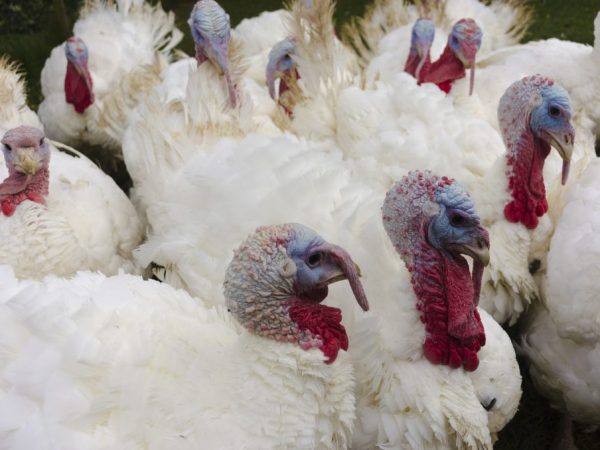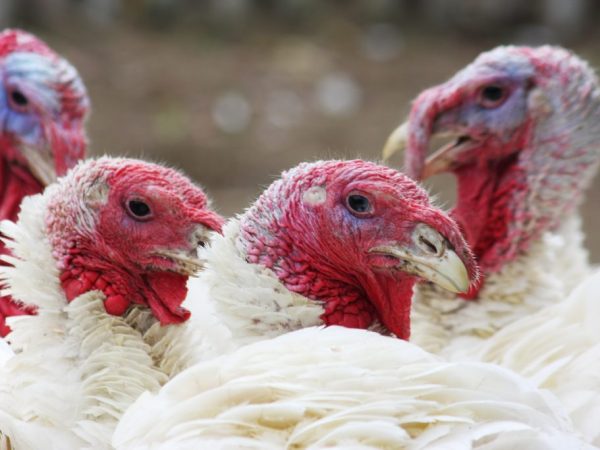Highbred turkey breed converter
Diet turkey meat has become the reason to breed these large poultry on private farms. Among the well-known breeds that give good performance indicators are the Highbread Converter turkeys.

Highbred turkey breed converter
General about the breed
The hybrid converter turkey breed, referred to by some as a convector, originated from the efforts of farmer breeders in Canada. The reason for the breeding was the desire to obtain a hybrid cross with high productive characteristics, and in two directions at once - egg and meat.
Russia appreciates the breed line for quality of turkey meat... The large body weight of poultry has become the reason for the emergence of the Russian comic name among domestic farmers - indostrauses.
Turkeys from Canada are based on blood broad-breasted bronze and Dutch white birds. They laid in the new cross-line unpretentiousness in care and maintenance, vitality and strength of the body constitution.
The new heavy cross hybrid converter obtained as a result of crossing has bypassed all other breed lines in popularity in its homeland and found its consumer outside the Canadian borders. Initially, they began to be bred on an industrial scale, and then they gradually switched to private farming.
Exterior cross-country differences
The description and photo of domestic birds characterizes them as broad-chested, the body of which is covered with a white feather, hiding muscle mass underneath. The head of birds is formed with clear lines, small in size, with wrinkled skin and a red outgrowth. Turkeys' legs look massive.
Males are distinguished among the entire livestock by their tail, which, when unfolded, looks like a large fluffy fan. Together with the fluffed tail feathers, the turkey begins a hike on a round ball.
The weight of poultry of the breed can be different:
- an average-sized male can gain weight up to 19-22 kilograms by the age of five months,
- at the same age, the weight of females is much more modest - from 9 to 12 kilograms.
A heavy meat hybrid cross created by Canadian breeders at an industrial scale of cultivation showed markedly high rates of egg and meat productivity. With proper care and nutritious diet Some Highbred Converter turkeys can gain up to 30 kilograms.
Domestic turkeys of the cross hybrid converter are capable of running at speeds up to 45 kilometers per hour and taking off to a height of up to two meters.
An overview of the breed can be viewed in the video.
Productive statistics
The breed of turkeys is classified as early maturing. According to the characteristics of the intensity of mass gain, the breed line, supplied in the form of a heavy cross by farms in France, England and Hungary, significantly surpasses many breeds available today in world agriculture. The Hybrid Converter hatching egg recorded high hatchability figures.
Each turkey carcass of a hybrid converter produces up to 80-85 percent of meat with high dietary characteristics, and almost one third of the total volume is breast meat pulp.
The plucked turkey carcass is quite attractive to the consumer. This was made possible by the external characteristics of poultry. At the same time, the more vegetables are contained in the diet of poultry, the more juicy and tender, according to the reviews of the owners and consumers.
The egg productivity of hybrid converter cross turkeys is also significant - an average of 50-80 large egg sizes per year. When providing poultry with a complete diet, increase the productivity of turkeys up to 100 eggs per year.
Soft turkey down is no less valuable in terms of product quality than eggs and meat.

Turkeys of this breed give good litter
The Hybrid Converter turkey is fertile enough to reach maturity closer to nine months of age. Males are capable of mating from the age of one. Hybrid turkey poults, which hatch already at 28-29 days, record a good survival rate - up to 85-90 percent. At the same time, in terms of feed return, this cross-line of turkeys is significantly in the lead in comparison with other species.
Turkeys of this breed line are ready to take care of their offspring, but they do not seek to hatch other people's chicks. When adding other people's eggs, the turkey will most likely bite them.
Quite similar in productivity to the English cross Big 6 turkey highbrids have some differences, which are shown in the table:
| Breed | hybrid converter | Big-6 |
| Average weight, kg | up to 20-22 males, up to 9-11 females | up to 24-26 males, up to 9-11 females |
| Output of turkey eggs, pieces | up to 50-80 | up to 100-105 |
| Slaughter age, days | from 150 | from 100 |
Incubation
For incubation The Hybrid Converter fits eggs with an intact shell surface, without dents or seals. In this case, natural inclusions are permissible. Before setting the hatching eggs for growing, they are translucent.
The quality of a turkey egg is the central location of its yolk, surrounded by a protein component with dense layers.
The egg incubation process includes:
- warming it up in order to remove condensate liquid, this is done to a temperature not higher than 20 degrees,
- marking so that eggs that have already been turned can be distinguished,
- vertical laying of eggs in automatic incubators and horizontal - in devices with mechanical control,
- regulation of humidity and temperature conditions.
After a week, the eggs are translucent for their rejection, and on the 25th day the temperature is raised to 27 degrees with an increase in humidity to 70 percent. Healthy turkeys hatch after 29 days. The newborn chick is freed from the shell and placed in a box, which is placed in a warm place where the temperature does not drop below 30 degrees.
Growing principles
You can breed and keep turkeys in any climatic conditions.
Requirements for the premises
Hybrid Converter turkeys are controversial. They can be quite tolerant and sociable with their relatives, they practically do not come into conflict with each other, however, living together with other poultry can cause difficulties.
For breeding, it is recommended to choose enclosures isolated with a net, given their ability to take off to a rather large height.
No more than two adult turkeys can live on one square meter of a dry and warm room, without drafts. The temperature regime is in the range of 18-20 degrees, in winter - at least 15. If you properly equip the premises where the turkeys will be kept, you do not have to worry that home turkeys will find it difficult to endure the cold seasons.
Stern
The Hybrid Converter Cross feed usually contains corn cobs, millet, oatmeal, or barley feed. For natural feeding, turkeys are organized special walking areas and sowed with grass - clover and alfalfa flowers, peas and vetch, dandelion or nettle.
Free-range poultry during the warm summer seasons allows them to quickly increase the required body weight.
Green food is a mandatory part of the diet of highbrid converter poults, which gives a good daily weight gain up to 5 months.
As with any poultry, turkeys need chalk and shells as a mineral supplement in their feed, especially when feeding highbred turkeys during their growth period.
Disease prevention
When raising young Hybrid Converter turkeys and keeping the young, it is recommended to adhere to the established vaccination plan, since turkeys are prone to various diseases, and immunity in birds develops over time.
For successful breeding of the Hybrid Converter breed and caring for turkeys, it is recommended to adhere to a number of rules on how to grow them best:
- mandatory inclusion of mineral and protein components in the feed ration,
- soldering poultry with medicines for intestinal diseases,
- the beginning of the slaughter period no later than the age of the turkeys at 4 months when they gain a mass of at least 7 kilograms.


